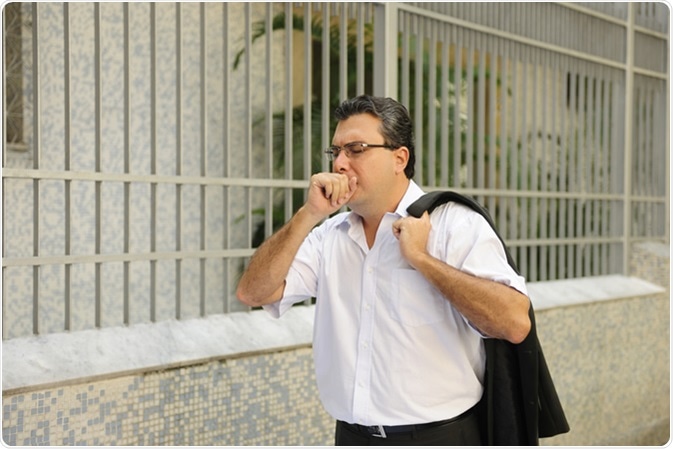
Walking Pneumonia
Pneumonia refers to an inflammation of the air sacs, called alveoli, present in the lung. The alveoli may begin to fill up with pus or fluids due to an infection or inflammation. It can be life-threatening. The condition may be caused by many bacterial or viral infections. The affected person will display symptoms such as a cough, fever, difficulty in breathing and chills.

Image Credit Mangostock / Shutterstock
It can be dangerous for adults but is often fatal for young children whose immune systems cannot withstand the severe infection. Pneumonia makes patients weak, robs them of energy and stamina, and very often requires hospitalization after the diagnosis is confirmed.
Walking pneumonia refers to a less serious infection of the lungs. Here the person affected is not so badly off as to require hospitalization or even bed rest. The symptoms are mild and the person may be able to go about their daily routine easily. It is caused by Mycoplasma pneumoniae bacteria as well as a couple of other organisms that creates symptoms akin to the common cold.
Symptoms of Walking Pneumonia
The person usually does not feel unwell enough to need to rest. Very often the illness is contracted by people who work in crowded areas such as schools. Common symptoms in those affected may include any of the following: some pain in the chest region, chills and shivers running down the body, a dry cough, headache, sore throat and high fever. The affected person may also suffer from excessive sweating. There may be a loss of appetite and vomiting.
Not all symptoms may be seen in every patient. The symptoms often take a couple of weeks to manifest properly. Some additional symptoms include ear pain, soreness of the eyes, muscles aching and stiffness in the joints. There may be a rash or lesions on the skin, or a lump may be form in the neck. The person may be breathing more rapidly than usual due to the strain on the lungs.
Diagnosing Walking Pneumonia
Since the initial symptoms are very mild, most people don’t realise that it is a serious respiratory illness till the symptoms persist for more than a couple of weeks. Ideally, symptoms of what resembles a common cold should not last longer than ten days. If this occurs, it would be advisable to get a medical assessment. Delay can cause the health to deteriorate faster.
The crackling sound that accompanies the breathing is a clear indicator of walking pneumonia to most health care providers. Medical evaluation of suspected pneumonia will require a chest x-ray. A CT scan of the chest is often ordered to diagnose most types of pneumonia.
In case of more severe symptoms, other tests which may be required include blood tests, bronchoscopy, nose or throat swabs to check for bacteria, sputum tests for mycoplasma bacteria, and measurements of the levels of carbon dioxide and oxygen in the blood. In extremely serious cases an open lung biopsy may also be required.
Treating Walking Pneumonia
Self-care can include keeping the fever down with NSAIDs like ibuprofen or naproxen, or acetaminophen. The patient should drink plenty of fluids and get adequate rest. Children should never be given aspirin as it may cause Reye syndrome. This is the occurrence of acute brain and liver damage in a child following exposure to this drug. It has been seen in cases where children suffering from chicken pox or flu were given aspirin. Should a child display prolonged cold symptoms, medical consultation is recommended.
Self-treatment with cough syrups should not be done, as it may make it more difficult to cough up the extra sputum. Should symptoms become more severe, antibiotics may be prescribed for about two weeks. Usually it is a 7 to 10 days course. The full course should be completed, rather than stopping the antibiotics once the patient feels better. If treatment is prematurely interrupted, the pneumonia may return and may be even more difficult to treat because of the emergence of resistant strains.
Complications That May Occur in Walking Pneumonia
While the prognosis for a full recovery is good once treatment is begun for walking pneumonia, there may be additional complications such as skin rashes, ear infections and hemolytic anemia. Hemolytic anemia is a medical condition wherein the body destroys its own red blood cells. The cough and weakness associated with walking pneumonia may persist for almost four to six weeks, even with treatment and medication.
Patients should remember that the infection, however mild, is contagious. Caregivers and patients should ensure that they regularly wash their hands with warm water and soap. Drinking glasses, plates, flatware, and toothbrushes should never be shared. While children are more prone to catch the infection, adults with a weak immune system are also at risk.
If the initial symptoms are ignored, the condition can deteriorate into full-blown pneumonia. The best way to avoid getting it is to take influenza vaccination every year, and to ask the health care provider if a preventive pneumonia vaccine would be useful.
References
- https://medlineplus.gov/ency/article/000082.htm
- http://kidshealth.org/en/parents/walking-pneumonia.html
- http://www.mayoclinic.org/diseases-conditions/pneumonia/expert-answers/walking-pneumonia/faq-20058530
Further Reading
Last Updated: Feb 27, 2019























.png)









No hay comentarios:
Publicar un comentario